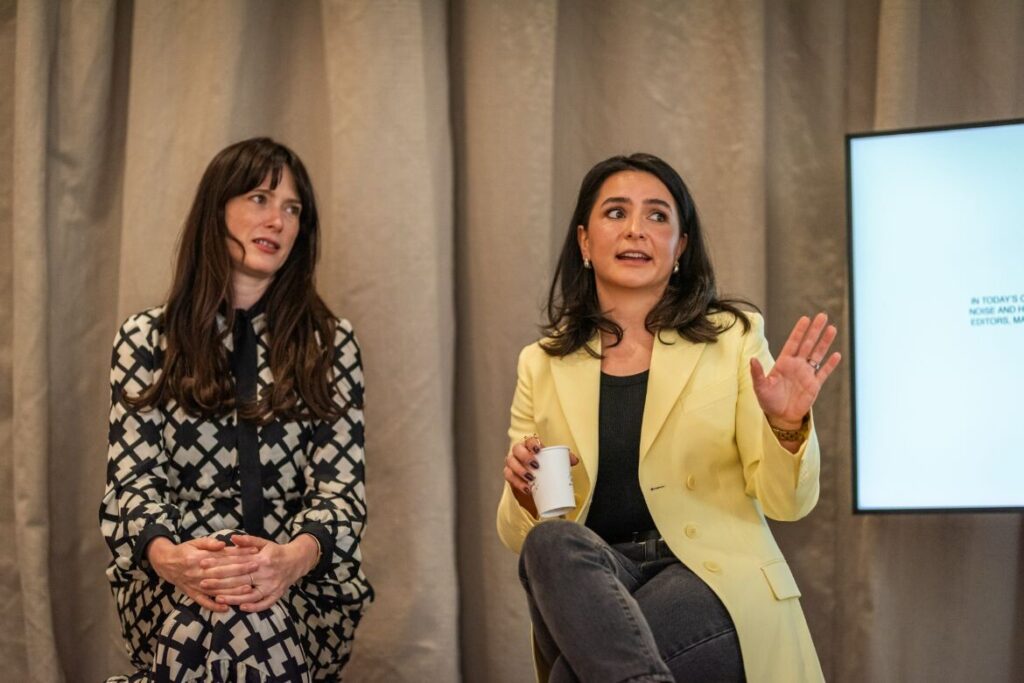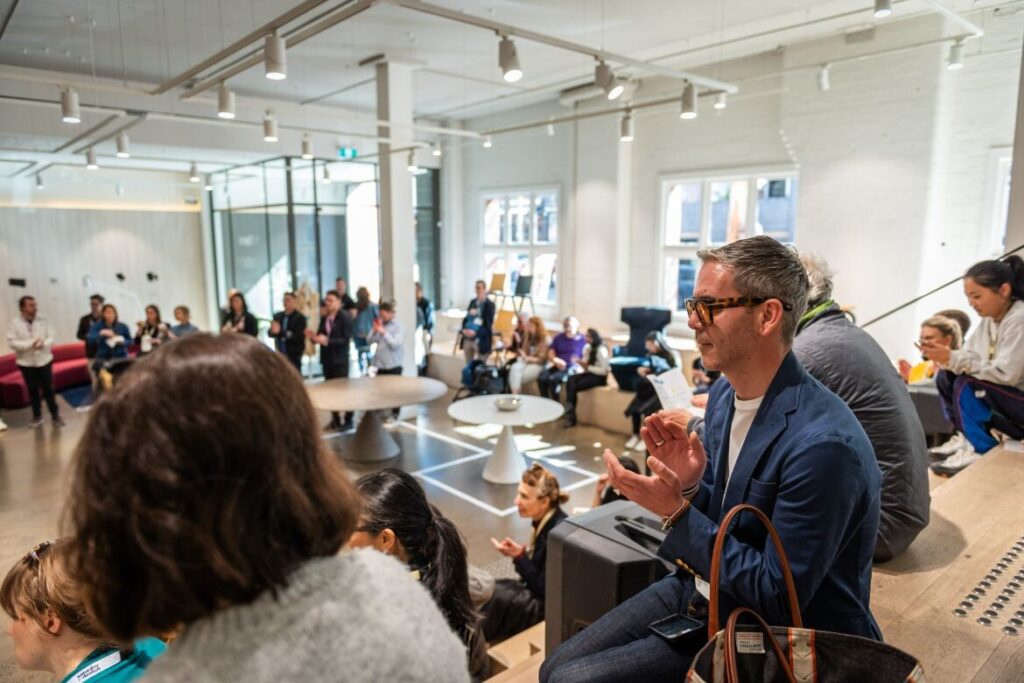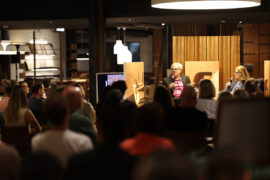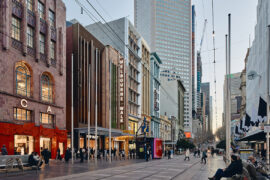How do we get cut-through in the current media landscape? Communications Collective’s Genevieve Brannigan shares her insights, tips and expert advice on prepping your media materials, making media reach outs and how to build clout using social media.

Pictured far right, Genevieve Brannigan of Communications Collective.
October 3rd, 2023
At Saturday Indesign in Melbourne (2 September 2023), a series of design discussion were held, spanning topics across architecture, design and also media and marketing. Held at ownworld‘s showroom in Collingwood, the ‘Publish Me!’ panel featured speakers Communication Collective director, Genevieve Brannigan, and Cera Stribley associate and founder of Meanwhile in Melbourne, Manuela Milan, with moderator Indesign editor, Alice Blackwood.
Following this packed-out discussion that saw audiences fill the showroom to standing-room-only, we catch up with Genevieve Brannigan to capture some of the indispensable insights shared at that session.
Prepare to be enlightened.
Genevieve: At Communications Collective, our portfolio of clients spans the built environment, architecture and design, art, and cultural spheres. It includes leading Australian businesses, brands, and organisations such as the Australian Institute of Architects, Department of Energy, Environment and Climate Action, Goodman Group, Fender Katsalidis, Orchard Piper and Museums Victoria among a long list of others.
Recently, we have worked on everything from positioning the creation of social value through design in the Australian media to creating brand strategies to support business development; from placemaking and community engagement projects to strategising for the release of Australia’s largest-ever liveability study.
Related: Catch up on all the Saturday Indesign highlights

The current media landscape is no doubt competitive, but it presents a valuable opportunity for brands, businesses, and individuals who are willing to invest time, research, and creativity into producing engaging media pitches that have a point of difference. Those who are succeeding in cutting through the ‘noise’ of an oversaturated market are not following a ‘cookie cutter’ approach in their communications strategies. Instead, they are exploring innovative new approaches to content and messaging based on concise storytelling and creative ‘angles’ or leads that reflect their business’s values and ethos.
I observe how challenging it is for brands and individuals to not only find this point of difference but to effectively communicate it in the current media landscape. It’s therefore more important than ever to craft pitches that are clear and concise, with a unique angle or ‘hook’ that engages people’s attention immediately.


When working with clients on preparing content and strategies for media outreach, we always encourage them to ask: What makes something newsworthy? Is this something an editor or journalist will really be interested to see in their (already jam-packed) inbox? It’s safe to say editors don’t want to receive PR pitches that are irrelevant to their readers.
Before approaching an editor or journalist, ensure you have done your research and you understand the tone, perspectives, and target audience of the publication.
Ask yourself: Is the story a good fit? Does it offer value? Is it new? Is it timely? Does it have relevance? Does it have prominence? Can it be linked to a broader trend? Does your imagery work with the style of the publication?
I also think it’s important to build relationships with key media, demonstrating to them in bite-sized, low-risk pieces that you are a reliable spokesperson. Take time to educate them about your business, areas of expertise, company, and projects before asking for (or expecting) a feature. Don’t expect they already know who you are, or what your business is about.
Related: Learnings from Saturday Indesign’s Design Discussions


It’s important that your social media channels – whether owned, earned, or paid – are an authentic reflection of your brand values. Find the stories behind your product, brand, or service and share them in a compelling way across your content ecosystem. It’s pretty obvious when a business is following a set of content ‘guidelines’ to supposedly increase engagement or following, and the content doesn’t reflect the nature or values of the business in any way.
Consider social media to be like an invitation into the ‘universe’ of your brand or business; from storytelling or design inspiration to celebrating company or project milestones, your aim is to engage with your audience and make them feel like they are part of your community. Don’t bore them, inspire them!
Find the platform that works best for you, your product, brand, or service, and experiment with content types, key messaging, and posting times to see what engages your audience. Review social media reports and understand what is working in your approach or content, what isn’t, and why.


We have to accept that AI will be part of PR and media moving forward, just as it has integrated into other aspects of our lives including art, design, property, and far beyond.
If we consider AI as a technological tool that can help the efficiency and accuracy of tasks like research, fact-checking, case studies, data collation, analysis, and the enhancement of viewer experience, then yes, I think it has a place in PR and media. It presents opportunities for us to engage with our tasks and projects on a deeper and more intricate level.
However, I don’t think AI can ever replace human creativity, emotion, and expression – especially when it comes to things like crafting innovative narratives for campaigns and projects, identifying emotive connections and values within a brand or business, or creating comms materials that genuinely connect with audiences on a human level, based on the lived experience.
If we can integrate AI into our work and use it strategically – in balance with our traditional approaches to research, strategy ideation, and content creation – then I think we can strike the right balance of efficiency, creativity, and quality outcomes in our work.

It’s essential to show and not just tell with your media materials. Think about how you can bring your story to life and add credibility via third-party experts, data and analytics, case studies, and creative assets.
You also need to ensure you get the tone and format of your material right. Journalists want to receive press releases written in plain, clear English. Avoid overly flowery language or excessive writing. It’s also important to consider the knowledge level and the interests of the reader, who might initially be the audience of a press release: What do they know about the subject? What would they like to know?
And of course, do your research! Understand the format and visual style of the publication you are pitching to. If you want to be published you will need to ensure your writing mirrors the editorial tone, structure, style, and perspectives of the publication. Also, ensure your release is grammatically correct and fact checked.

Research who your audience is, and make sure that you understand them. Ensure your story or media material is compelling, and that you provide relevant supporting data, evidence, anecdotes, and case studies to ensure that it shows, not just tells. Consider the format and structure of your material and try to make it concise, with all key information in the first paragraph.
I suggest following the format: Who, What, When, Where, Why, and How, as this will act as a guide and ensure you cover all key points.
Lastly, follow up with a call. Don’t underestimate the power of a conversation to reinforce the main idea of your pitch, and to ensure it stays top of mind for media.
We are delighted to be working with Geelong Design Week on a strategic media engagement program to amplify this year’s incredible program (launching in October) and local creativity more generally, as well as supporting the Victorian State Government in communicating the vision and objectives of its Future Homes initiative; a new higher-density housing model template for Victoria.
Planning for our 2024 Collectivity Talks program is also underway, which will see us participate in major national design events and showcases including Vivid Sydney and Melbourne Design Week alongside a host of industry thought leaders and changemakers.
Genevieve Brannigan is the director of Communications Collective.
Communications Collective
communicationscollective.com.au
INDESIGN is on instagram
Follow @indesignlive
A searchable and comprehensive guide for specifying leading products and their suppliers
Keep up to date with the latest and greatest from our industry BFF's!
The new range features slabs with warm, earthy palettes that lend a sense of organic luxury to every space.

Welcomed to the Australian design scene in 2024, Kokuyo is set to redefine collaboration, bringing its unique blend of colour and function to individuals and corporations, designed to be used Any Way!

Rising above the new Sydney Metro Gadigal Station on Pitt Street, Investa’s Parkline Place is redefining the office property aesthetic.

He’s the Director of Eames Office and an all-round creative polymath – and Eames Demetrios has just been in our region with Living Edge.
The internet never sleeps! Here's the stuff you might have missed

A new book documents the city’s historic building interiors, from 1800s coffee palaces to post-war modernist spaces.

Buchan weaves heritage and contemporary retail across a 3,600sqm site featuring dual-branded hotels, arcades and revitalised laneways.